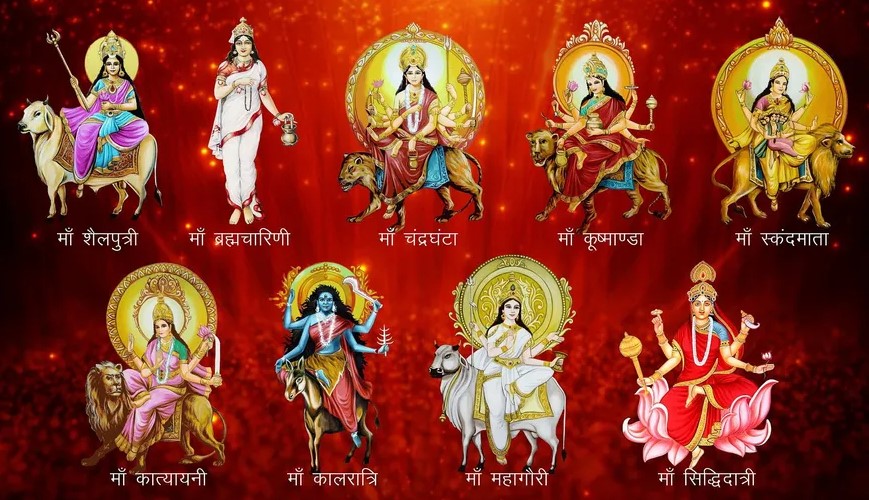
Navratri, a vibrant and spiritually significant Hindu festival, is a nine-night celebration that pays homage to the divine feminine and the nine different forms of the Goddess. The term “Navratri” is a combination of two words, “Nav” meaning nine and “Ratri” meaning night. This festival is celebrated with great enthusiasm and devotion twice a year, during Chaitra Navratri in the spring and Sharad Navratri in the autumn. Sharad Navratri, also known as Maha Navratri, is the most widely celebrated of the two.
The essence of Navratri lies in the worship of the nine forms of the Goddess, commonly referred to as the “Navadurga.” These nine manifestations of the divine feminine represent various facets of life, from power and courage to wisdom and creativity. Each form of the Goddess is celebrated during the nine nights of Navratri, with devotees engaging in prayers, fasting, and various cultural festivities. This article delves into the significance of Navratri and the reverence accorded to the Nine Goddess Mothers during this auspicious time.
Day 1: Shailaputri – The Daughter of the Mountain
Navratri commences with the worship of Shailaputri, who is also known as Sati. The name “Shailaputri” translates to “Daughter of the Mountain,” which is a reference to her being the daughter of King Himavan, the personification of the Himalayas. She is often depicted riding a bull and holding a trident. Devotees seek her blessings for strength and courage. The color associated with the first day of Navratri is gray, representing the stability and power of the mountains.
Day 2: Brahmacharini – The Ascetic Goddess
On the second day of Navratri, Brahmacharini is revered. Her name “Brahmacharini” means “one who practices devout austerity.” She is depicted as walking with a rosary and a water pot. This form of the Goddess symbolizes penance, purity, and devotion. Devotees pray to Brahmacharini for guidance on the path of righteousness. The color for this day is orange, signifying energy and enthusiasm.
Day 3: Chandraghanta – The Goddess with the Crescent Moon
Chandraghanta is the third form of the Goddess, and she is named after the crescent moon (Chandra) on her forehead. She is depicted with ten arms and is believed to bestow peace and serenity upon her devotees. The sound of her bell is said to dispel negativity and bring positivity. The color of the day is bright yellow, symbolizing grace and prosperity.
Day 4: Kushmanda – The Creator of the Universe
Kushmanda is the fourth form of the Goddess, and her name means “the cosmic egg.” She is believed to have created the universe with her divine smile. With eight arms, she holds various weapons and symbols of power. Devotees worship Kushmanda for strength and vitality. The color associated with this day is green, representing new beginnings and growth.
Day 5: Skandamata – The Mother of Skanda (Lord Kartikeya)
On the fifth day of Navratri, Skandamata is venerated as the mother of Lord Kartikeya (Skanda), the god of war. She is depicted holding her son, Skanda, in one of her arms. Her peaceful demeanor signifies motherly love and care. Devotees pray to Skandamata for the well-being of their children. The color for this day is gray, symbolizing the transformation of the devotee’s life.
Day 6: Katyayani – The Warrior Goddess
Katyayani is the sixth form of the Goddess, and she is known for her warrior-like appearance. She is often depicted riding a lion and wielding a sword. Devotees seek her blessings for courage and protection from evil. The color for this day is orange, symbolizing hope and optimism.
Day 7: Kalaratri – The Dark and Fierce Goddess
Kalaratri, the seventh form of the Goddess, is known for her fierce appearance and dark complexion. She is believed to destroy ignorance and darkness. Devotees pray to her to remove obstacles and negative forces from their lives. The color of the day is white, signifying purity and peace.
Day 8: Mahagauri – The Radiant and Compassionate Goddess
Mahagauri, the eighth form of the Goddess, is depicted as a radiant and compassionate deity. She is often dressed in white attire and represents purity and peace. Devotees seek her blessings for happiness and prosperity. The color for this day is pink, symbolizing love and hope.
Day 9: Siddhidatri – The Granter of Boons
The final day of Navratri is dedicated to Siddhidatri, the Goddess who grants wishes and bestows special abilities to her devotees. She is often shown seated on a lotus with a mace, a discus, and a conch in her hands. Devotees seek her blessings for spiritual growth and enlightenment. The color of the day is sky blue, representing a sense of infinity and divinity.
The Essence of Navratri
Navratri is a festival that celebrates the divine feminine in all her aspects. It is a time for introspection, devotion, and self-discovery. The nine nights of Navratri are a spiritual journey that allows devotees to connect with the Goddess, seek her blessings, and reflect on the different dimensions of life. Through fasting, prayer, and various cultural activities, individuals purify their minds and bodies, and in doing so, they draw closer to the divine.
The festival also serves as a reminder of the importance of gender equality and the empowerment of women. The Goddess, in her various forms, embodies the qualities of strength, wisdom, compassion, and creativity. By celebrating these aspects of the divine feminine, Navratri encourages society to recognize and respect the inherent power and grace of women.
Navratri is not only a religious festival but a celebration of culture, tradition, and the rich heritage of India. It brings people together in a spirit of joy, devotion, and unity while promoting self-discipline and spirituality. The worship of the Nine Goddess Mothers during Navratri is a testament to the profound significance of the divine feminine in Hinduism and serves as an inspiration for all to embrace these qualities in their own lives.
